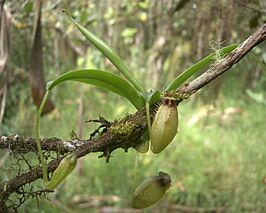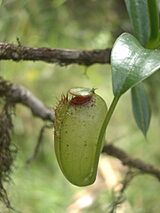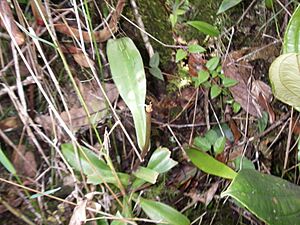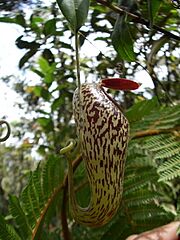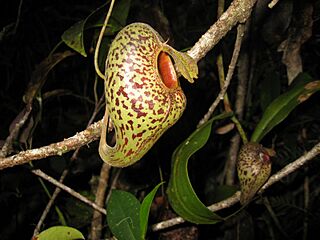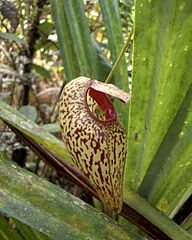Nepenthes aristolochioides facts for kids
Quick facts for kids Nepenthes aristolochioides |
|
|---|---|
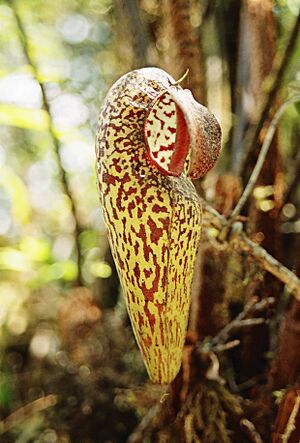 |
|
| An upper pitcher of N. aristolochioides | |
| Conservation status | |
| Scientific classification | |
| Genus: |
Nepenthes
|
| Species: |
aristolochioides
|
The Nepenthes aristolochioides is a special kind of pitcher plant that grows only on the island of Sumatra in Indonesia. It lives high up in the mountains, usually between 1,800 and 2,500 meters (about 5,900 to 8,200 feet) above sea level. This plant is famous for its very unusual pitchers, which are shaped like pots and have an opening that faces almost straight up! Sadly, it is in great danger because too many people try to collect it from the wild.
The name aristolochioides means "resembling Aristolochia". This is because its pitchers look a lot like the unique flowers of a different plant called Aristolochia, both in their shape and colors.
Contents
Discovering This Unique Plant
The Nepenthes aristolochioides was first found by a botanist named Willem Meijer on August 5, 1956. He collected it from Mount Tujuh in Jambi, Sumatra. For over 30 years, this plant specimen was mostly forgotten.
Then, in 1988, another botanist, Joachim Nerz, saw it at a herbarium (a plant museum) in Leiden, Netherlands. He became very interested in this mysterious plant. In 1996, Nerz went on a trip to Sumatra and successfully found N. aristolochioides growing in the wild again!
Finally, in 1997, two botanists, Matthew Jebb and Martin Cheek, officially described and named the species in a science journal. Later, other scientists like Charles Clarke and Stewart McPherson studied and wrote more about this amazing plant.
What Does Nepenthes aristolochioides Look Like?
This plant is a climbing plant. Its stem can grow up to 8 meters (about 26 feet) long and is about 5 millimeters (0.2 inches) thick. It uses its long stems to climb up trees and other plants.
Leaves
The leaves of N. aristolochioides are thick and leathery. They are usually long and narrow, growing up to 20 centimeters (8 inches) long and 5 centimeters (2 inches) wide. Each leaf has a special part called a tendril, which is like a curly vine. These tendrils can grow up to 15 centimeters (6 inches) long and are what the pitchers grow from.
Pitchers: The Traps
The most interesting part of N. aristolochioides is its pitchers, which are its traps. Unlike many other pitcher plants, its lower pitchers (those close to the ground) and upper pitchers (those higher up) look quite similar.
- Lower Pitchers: These pitchers are usually shaped like a wide funnel at the bottom and then become round like a ball at the top, forming a dome over the opening. They can be up to 7 centimeters (2.8 inches) tall and 3 centimeters (1.2 inches) wide. They have two "wings" running down the front, which sometimes have fringes. The opening of the pitcher can be horizontal, slanted, or almost vertical. The inside of the pitcher is very sticky and glandular, meaning it produces digestive fluids. The rim around the opening, called the peristome, is wide and curves inward. The lid of the pitcher is round or oval and has no special parts, but it has many nectar glands underneath to attract insects.
- Upper Pitchers: These are usually larger, growing up to 15 centimeters (6 inches) tall and 8 centimeters (3 inches) wide. They are funnel-shaped at the bottom and have a clear, dome-like top. The opening of the upper pitcher is even more slanted, almost vertical! The inside of these pitchers is also very sticky and glandular. The peristome (rim) is wide and curves inward, forming a kind of "entrance corridor." The lid is round or oval and often sits flat, at a right angle to the pitcher opening. It also has many nectar glands.
Colors
The stems, leaves, and tendrils of the plant are usually yellowish-green. The pitchers are white to reddish on the outside with many reddish-brown or purple spots. The spots are often darker and closer together near the top of the pitcher. The peristome (rim) is usually dark red or purple. The underside of the lid is dark red or purple, while the top of the lid is spotted like the rest of the pitcher. The inside of the pitcher is white to light yellow.
Where Does It Live?
N. aristolochioides lives only in Sumatra, Indonesia, in mossy forests near the tops of steep ridges. It grows at high altitudes, between 1,800 and 2,500 meters above sea level. It usually grows on the ground, but it can also grow on tree trunks in mossy areas.
This plant shares its habitat with other pitcher plants like N. gymnamphora and N. singalana. Even though they live in the same area, they seem to have different ways of life. For example, N. singalana often stays on the forest floor, while N. aristolochioides climbs high into the trees.
Is It Endangered?
Yes, N. aristolochioides is listed as Critically Endangered on the IUCN Red List of Threatened Species. This means it is at very high risk of disappearing forever. Even though it lives inside Kerinci Seblat National Park, it is still in danger. People illegally collect these plants because their unique pitchers are so special. In 2007, one scientist only saw a single N. aristolochioides plant on Mount Tujuh, where it was first discovered! To help save it, a special collection called the Rare Nepenthes Collection was started in 2010 to protect this and other endangered Nepenthes species.
How Does It Catch Food?
N. aristolochioides has different ways of trapping insects, depending on whether it's a lower or upper pitcher.
Ground Traps
The lower pitchers often grow hidden in Sphagnum moss, with only their tops showing. Scientists think these act like simple pitfall traps for insects that walk on the ground. Insects crawl into the small opening and fall to the bottom. They can't climb out and drown in the digestive fluid.
Light Traps
The upper pitchers of N. aristolochioides have a special trick: their dome-shaped tops have clear patches that let sunlight shine into the pitcher. When you look at the pitcher from the front, the rim and lid look dark, but the inside of the pitcher is very bright. Scientists believe this bright light attracts flying insects, especially small flies, which are drawn to light sources.
Once inside, the insects become confused because they can't find the exit. They fly around, get disoriented, and eventually fall into the sticky fluid at the bottom and drown. This kind of trap is sometimes called a "lobster-pot trap" because it's easy to get in but hard to get out! Experiments have shown that if the clear dome is covered, the plant catches far fewer insects.
Sticky Traps
N. aristolochioides produces a very thick, sticky liquid inside its pitchers. This liquid coats the entire inner surface of the trap like a thin film. This means the pitchers also work like "flypaper traps", where flying insects get stuck to the sticky walls above the fluid. Other similar Nepenthes species from Sumatra also have this very sticky pitcher fluid.
Similar Plants
The unique shape of N. aristolochioides's pitchers, especially their almost vertical opening, makes it very easy to tell apart from other plants. No other Nepenthes species has a pitcher mouth quite like it.
It shares some features with N. talangensis, but N. talangensis has a horizontal pitcher opening and a short neck, which N. aristolochioides does not. Also, N. talangensis usually grows only on the ground, while N. aristolochioides can climb high into the trees.
Scientists have studied how different Nepenthes species are related. N. aristolochioides is thought to be related to species like N. tenuis, N. dubia, and N. inermis, which also have unique pitcher shapes and sticky fluids.
Even though N. aristolochioides and N. klossii both have clear domes on their pitchers, they are not closely related. Their similar traps are an example of "convergent evolution", where different species develop similar features because they live in similar environments and face similar challenges.
Natural Hybrids
Sometimes, two different plant species can cross-pollinate and create a new plant called a natural hybrid. Only one natural hybrid involving N. aristolochioides is known: Nepenthes aristolochioides × N. singalana. This hybrid is quite rare and has been found on Mount Tujuh. It is smaller than both of its parent plants, with pitchers rarely growing taller than 5 centimeters (2 inches). Its pitchers look a bit like N. talangensis, but they have more noticeable teeth on the rim.



